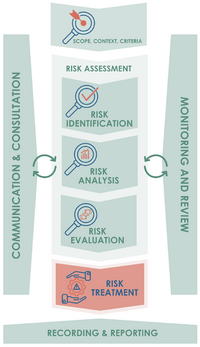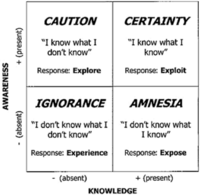Managing threats and opportunities in risk treatment
Developed by Theis Rosenkvist Sørensen
Risk treatment is the final stage in the risk management process. It is used to control and monitor the uncertainties during the project. When managing a project, uncertainties are one of the most important factors to control in order to achieve a successful project. Uncertainties occur when certain events in a project are unpredictable and it will only be possible to guess about a future event. Risk management is used to identify risks in the project that help maintain stability and used to prevent unforeseen events that can be cost, resource or time consuming. By using risk management, it is possible to ensure that the project team achieves the goals they are solving by not encountering many unpredictable obstacles during the project.
The risk management process is a seven-step monitoring process: Communication & Consultation, Establish Context/Scope/Criteria, Identify Risks, Analyze Risks, Evaluate Risk, Risk treatment and Monitoring & Review [1]. This is done throughout the projects lifetime. By managing the project using responses to threats and opportunities, it becomes possible to minimize the impact of the risk. If it can be done in a successful way, better risk management is achieved and it will thus be possible to reduce the impact of the uncertainties in the project.
By using Rumsfeld's (un)known-unknowns, it becomes possible to reduce the risk by establishing precautions that can prevent or reduce the uncertainties from arising.
When working with risk treatment, there are some limitations. One of the crucial limitations is the lack of knowledge sharing. The lack of knowledge sharing leads to a greater amount of uncertainties that could have been prevented. However, not all uncertainties can be prevented and even perfectly planned projects have their limitations. By having a greater amount of expertise, a higher level of risk treatment can be performed and will minimize the risk by identifying crucial uncertainties in the project.
Contents |
Introduction
The Risk Management Process

Risk management is a process that works to manage risks to ensure that it cause the least impact in the project. Risk management is based on assumptions and experience from previous projects. However, many assumptions are uncertain which can have an effect on the project's original scope. The Project Management Institute (PMI), describes risks as "An uncertain event or condition that, if it occurs, has a positive or negative effect on one or more project objectives" [2]. By successfully navigating the uncertainty, risk can be managed in a way that is most beneficial to the project scope.
The process involves a "systematic application of policies, procedures and practices to the activities of communicating and consulting, establishing the context and assessing, treating, monitoring, reviewing, recording and reporting risk" [1]. It should be noted that there can be many different applications of the risk management process, as it can be adapted to a particular project to achieve specific goals within the organization.
When operating the risk management process, take into account that the process is an iterative approach and it is important to go back and assess whether there have been changes in the previous stages that could create new potential risks that the project manager needs to adapt in their risk assessment. The stages are illustrated in Figure 1 [1].
WILL BE DELETED:
ref PMI: [2]
Knowledge and awareness

David Hillson describes the difference between risk and uncertainties. He states that "risk" has a set of possible outcomes that are known, but that the precise outcome is not known in advance. In contrast, uncertainties relates to a lack of knowledge about the possible outcomes and are thus an unknown event from an unknown number of possible outcomes [3].
Based on these descriptions, the relationship between risk and uncertainty can be described as:
"Risk is measurable uncertainty"; "Uncertainty is unmeasurable risk" [3].
Another way to distinguish the relationship between risk and uncertainty is by looking at the relationship between knowledge and awareness. Figure 2 illustrates four quadrants where knowledge and awareness are either present or absent. The top right corner of the quadrant certainty is illustrated, where both awareness and knowledge are present. An example could be a known number of square meters on which a building must be built or the appearance of the building so that it fits a certain cityscape. The top left corner illustrate caution, which describe the things that are uncertain. This could be, for example, the weather conditions next week. Under certainty we have amnesia which describes the lack of awareness or a blind spot regarding the knowledge we have. This could be, for example, bad planning, poor communication or acting on intuition and biases. The project manager can practice self-awareness to identify them. The last quadrant is Ignorance, where "we don't know what we don't know". An example of this could be the beginning of a war or an unpredictable natural disaster.
The knowledge and awareness figure created by Hillson is a comparison to the known description used by the former U.S. Secretary of Defense Donald Rumsfeld at a press confeence in 2002. He described the types of uncertainties as and is known by the fraise:
"Reports that say that something hasn't happened are always interesting to me, because as we know, there are known knowns; there are things we know we know. We also know there are known unknowns; that is to say we know there are some things we do not know. But there are also unknown unknowns – the ones we don't know we don't know" [4].
Donald Rumsfeld, United States Secretary of Defense, February 12, 2002
Better known as Donald Rumfeld's Unknown-Unknowns
NOTE: Another way to distinguish between risks and uncertainties is by looking at the relationship between knowledge and awareness. Hillson has used a concept similar to the Johari Window figure, where you work with 4 quadrants that describe knowledge and awareness
Donald Rumfeld's Unknown-unknowns
Donald Rumfeld builds on the concept of describing the 4 types of uncertainty as; Known-known which describes the things we know that we know. Unknown-Known...
Donald Rumsfeld describes 4 types of uncertainties
abc
Hillson, David. "Effective Opportunity Management for Projects - Exploiting Positive Risk", 2003. Ch. 1. "The case for opportunity management". Marcel Dekker Inc.
Risk Management Process
abc
Hillson, David. "Effective Opportunity Management for Projects - Exploiting Positive Risk", 2003. Ch. 1. "The case for opportunity management". Marcel Dekker Inc.
Risk Treatment
The importance of risk treatment lies in the fact that risks are decisive for whether a project will be a success or not. By not managing the risks, the consequence can be fatal. Barry Boehm states the consequence as "If you don’t actively attack the risks, they will actively attack you" [5].
Risk management is driven by the desire to succeed.
ref: Forsberg, K., & Mooz, H. RISK AND OPPORTUNITY MANAGEMENT. (1996). INCOSE International Symposium, pp. 586–598. Retrieved from https://doi.org/10.1002/j.2334-5837.1996.tb02057.x
NOTES:
When reacting to threats, ARTA (Avoid, Reduce, Transfer, Accept) can be used as an approach to the Risk Management Process. The goal is to reduce the impact to zero by either avoiding, reducing or transferring the risks.
Some of the response strategies to threats and Opportunities will also be highlighted in this article
By using risk management, it is possible to ensure that the project team achieves the goals they are solving
Risk management is a five-step monitoring process that establishes context, identifies, analyzes, evaluates and addresses potential risks over the life of a project.
Risk can be either threats or opportunities...
Risk treatment is a way to manage and act on the identified risks.
(CONTENT)
This is a page will be elaborated on the following topics:
- Managing threats and opportunities in risk treatment introduction (known knowns?, risk management, risk treatment)
- Risk management process (the 5 stages in the risk management process)
- Responses to threats and opportunities
- Discussion and conclusion
- References
NOTES FOR ABSTRACT:
The goal is to take procortions for the uncertainties and reduce the impact it can we on the project. This can be done by...
In project management there is a lot of uncertainties we need to prepare and take procortions for. By doing this it will be possible to prevent unknown factors that can occure. mannaging thorugout the whole projct.
The 5 steps in risk management
responding to threats - ARTA
Responding to opportunities
Annotated Bibliography
Articles
- Project Management Institute, Inc. (PMI). (2021). A Guide to the Project Management Body of Knowledge (PMBOK ® Guide) – 7th Edition and The Standard for Project Management. (pp. 114-125). Project Management Institute, Inc. (PMI). [2]
- DESCRIPTION
- Danish Standards Association (2018), DS/ISO 31000:2018, Risk management - Guidelines. [1]
- DESCRIPTION
Books
- Hillson, David. "Effective Opportunity Management for Projects - Exploiting Positive Risk", 2003. Ch. 1. "The case for opportunity management" [3]
- Description
Transcript
- Rumsfeld, Donald. "Defense.gov News Transcript: DoD News Briefing – Secretary Rumsfeld and Gen. Myers, United States Department of Defense (defense.gov)". February 12, 2002. [4]
- A transcript of Donald Rumsfeld gave to a question at a U.S. Department of Defense (DoD) news briefing on February 12, 2002.
References
- ↑ 1.0 1.1 1.2 1.3 1.4 Danish Standards Association (2018), DS/ISO 31000:2018, Risk management - Guidelines, Retrieved from https://sd.ds.dk/Viewer/Standard?ProjectNr=M296412&Status=60.60&VariantID=41&Page=0
- ↑ 2.0 2.1 2.2 2.3 Project Management Institute, Inc. (PMI). (2021). A Guide to the Project Management Body of Knowledge (PMBOK ® Guide) – 7th Edition and The Standard for Project Management. (pp. 114-125). Project Management Institute, Inc. (PMI). Retrieved from https://app.knovel.com/hotlink/pdf/id:kt012LZJB1/guide-project-management/opportunities
- ↑ 3.0 3.1 3.2 3.3 3.4 Hillson, David. "Effective Opportunity Management for Projects - Exploiting Positive Risk", 2003. Ch. 1. "The case for opportunity management". Marcel Dekker Inc.
- ↑ 4.0 4.1 Rumsfeld, Donald. "Defense.gov News Transcript: DoD News Briefing - Secretary Rumsfeld and Gen. Myers, United States Department of Defense (defense.gov)". February 12, 2002. Retrieved from https://archive.ph/20180320091111/http://archive.defense.gov/Transcripts/Transcript.aspx?TranscriptID=2636#selection-1053.10-1053.342
- ↑ Forsberg, K., & Mooz, H. RISK AND OPPORTUNITY MANAGEMENT. (1996). INCOSE International Symposium, pp. 586–598. Retrieved from https://doi.org/10.1002/j.2334-5837.1996.tb02057.x
Made by Theis Sørensen (s195768)